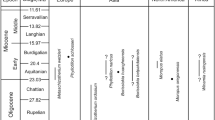Abstract
New material of a chalicothere was recently found from Tsaidam Basin, the only late Tertiary locality within the northern Qinghai-Tibetan Plateau established byBirger Bohlin during the Sino-Swedish Expeditions in 1927–33. A partial lower jaw with two molars helps to identify it asChalicotherium cf.C. brevirostris (Colbert), a species found in Chinese Tunggurian age (middle Miocene).
Occurrence ofChalicotherium in the Tsaidam Basin indicates the presence of a wooded environment along freshwater streams, a condition much milder than the desert environment at the present time. The Tsaidam fauna thus provides a reference point in the current debate on the timing of environmental deterioration during the uplift of Tibetan Plateau.
Zusammenfassung
Neufund vonChalicotherium aus dem späten Miozän des Tsaidam-Beckens, nördliches Qinghai-Tibet-Plateau, China. Der Neufund einesChalicotherium stammt aus dem Tsaidam-Becken, der einzigen jungtertiären Fundstelle vom nördlichen Qinghai-Tibet-Plateau, entdeckt vonBirger Bohlin während der Chinesisch-Schwedischen Expeditionen 1927–33. Ein fragmentarischer Unterkiefer mit 2 Molaren ermöglicht die Bestimmung alsChalicotherium cf.Ch. brevirostris (Colbert), einer Art, die aus dem chinesischen Tunggurium (Mittel-Miozän) bekannt war.
Das Vorkommen vonChalicotherium im Tsaidam-Becken bezeugt eine bewaldete Umwelt entlang von Flüssen und somit viel mildere Verhältnisse als die heutigen Wüsten. Die Tsaidam-Fauna stellt daher einen Bezugspunkt in der derzeitigen Diskussion dar über den zeitlichen Rahmen von Umweltverschlechterungen während der Hebung des Tibetischen Plateaus.
Similar content being viewed by others
Abbreviations
- AMNH:
-
Department of Vertebrate Paleontology, American Museum of Natural History, New York
- DKO:
-
Dytiko locality of Université de Thessaloniki
- GSP:
-
Geological Survey of Pakistan Museum, Quetta
- HSB:
-
Heimatmuseum Stegersbach im Burgenland, Austria
- IVPP:
-
Institute of Vertebrate Paleontology and Paleoanthropology, Chinese Academy of Sciences, Beijing
- NMB:
-
Naturhistorisches Museum, Basel
- NMV:
-
Naturhistorischen Museums, Vienna
- PIUU:
-
Palaeontological Institute, Uppsala University, Uppsala
- XBDD:
-
Department of Geology, Northwest University (Xibei Daxue), Xi’an
Literature
Bohlin, B. 1937. Eine Tertiäre Säugetier-fauna aus Tsaidam. - Sino-Swedish Expedition Publication (Palaeontologia Sinica Series C, Volume 14)1: 3–111.
Bohlin, B. 1945. Palaeontological and geological researches in Mongolia and Kansu 1929–1933. - Sino-Swedish Expedition Publication26: 257–325.
Bohlin, B. 1960. Geological reconnaissances in western Kansu and Kokonor. - Sino-Swedish Expedition Publication44: 1–79.
Bonis, L.D.;Bouvrain, G.;Koufos, G.D. &Tassy, P. 1995. Un crane de chalicothere (Mammalia, Perissodactyla) de Miocene superior de Macédoine (Grece): remarques sur la phylogenie des Chalicotheriinae. -Palaeovertebrata, Montpellier (1-2)24: 135–176.
Colbert, E.H. 1934. Chalicotheres from Mongolia and China in the American Museum. - Bulletin of the American Museum of Natural History67: 353–387.
Coombs, M.C. 1983. Large mammalian clawed herbivores: A comparative study. - Transactions of the American Philosophical Society73: 1–96.
Fort, M. 1996. Late Cenozoic environmental changes and uplift on the northern side of the central Himalaya: a reappraisal from field data. - Palaeogeography, Palaeoclimatology, Palaeoecology120: 123–145.
Gill, Th. 1872. Arrangement of the families of mammals and synoptical tables of characters of the subdivisions of mammals. -Smithsonian Miscellaneous Collections11 (230): 1–98.
Hu, C.-K. 1959. Chalicothere fossils from the Tertiary of North China. - Paleovertebrata et Paleoanthropologia1: 125–132 [in Chinese].
Kaup, J.J. 1833. Descriptions d’ossements fossiles de mammifères inconnus jusqu’à présent qui se trouvent au Musée grand ducal de Darmstadt. Second cahier: 1–31, Darmstadt.
Owen, R. 1848. Description of teeth and portions of jaws of two extinct anthracotherioid quadrupeds (Hyopotamus vectianus andHyopotamus bovinus) discovered by the Marchioness of Hastings in the Eocene deposits on the N.W. coast of the Isle of Wight: with an attempt to develope Cuvier’s idea of the classification of pachyderms by the number of their toes. - Contributions to the History of British Fossil Mammals (First Series)7: 30–71.
Pickford, M. 1982. Miocene Chalicotheriidae of the Potwar Plateau, Pakistan. - Tertiary Research (1)4: 13–29.
Qiu, Z.-x. 1990. The Chinese Neogene mammalian biochronology - its correlation with the European Neogene mammalian zonation. -In:Lindsay, E.H.;Fahlbusch, V. &Mein, P., eds., European Neogene Mammal Chronology: 527–556, New York (Plenum Press).
Qiu, Z.-X. &Qiu, Z.-D. 1995. Chronological sequence and subdivision of Chinese Neogene mammalian faunas. -Palaeogeography, Palaeoclimatology, Palaeoecology116: 41–70.
Schaefer, H. &Zapfe, H. 1971.Chalicotherium grande Blainv. undChalicotherium goldfussi Kaup. odontologische und osteologische Unterschiede. - Verhandlungen der Naturforschenden Gesellschaft in Basel81: 157–199.
Schlosser, M. 1903. Die fossilen Säugethiere Chinas nebst einer Odontographie der recenten Antilopen. -Abhandlungen der königlich-bayerischen Akademie der Wissenschaften22: 1–221.
Wang, J.;Wang, Y.-J.;Liu, Z.-C;Li, J.-I. &Xi, P. 1999. Cenozoic environmental evolution of the Qaidam Basin and its implications for the uplift of the Tibetan Plateau and the drying of central Asia. -Palaeogeography, Palaeoclimatology, Palaeoecology152: 37–47.
Xue, X.-X. &Coombs, M. C. 1985. Anew species ofChalicotherium from the upper Miocene of Gansu Province, China. - Journal of Vertebrate Paleontology5: 336–344.
Zapfe, H. 1979.Chalicotherium grande (Blainv.) aus der miozänen Spaltenfüllung von Neudorf an der March (Devinská Nova Ves), Tschechoslowakei. - Neue Denkschriften des Naturhistorischen Museums in Wien2: 1–282.
Author information
Authors and Affiliations
Rights and permissions
About this article
Cite this article
Wang, X., Wang, B. New material ofChalicotherium from the Tsaidam Basin in the northern Qinghai-Tibetan Plateau, China. Paläontol Z 75, 219–226 (2001). https://doi.org/10.1007/BF02988015
Received:
Accepted:
Published:
Issue Date:
DOI: https://doi.org/10.1007/BF02988015




